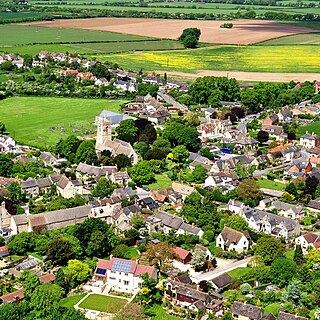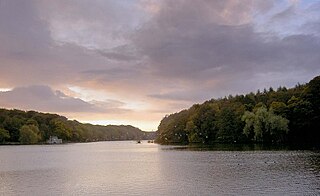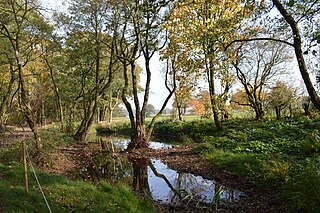Related Research Articles

Oxfordshire is a ceremonial county in South East England. The county is bordered by Northamptonshire and Warwickshire to the north, Buckinghamshire to the east, Berkshire to the south, and Wiltshire and Gloucestershire to the west. The city of Oxford is the largest settlement and county town.

Newmillerdam is a village and suburb of Wakefield, in West Yorkshire, England. The name refers to the lake and country park adjacent to the village. The park is a local nature reserve.

Ordsall Hall is a large former manor house in the historic parish of Ordsall, Lancashire, England, now part of the City of Salford, in Greater Manchester. It dates back more than 750 years, although the oldest surviving parts of the present hall were built in the 15th century. The most important period of Ordsall Hall's life was as the family seat of the Radclyffe family, who lived in the house for more than 300 years. The hall was the setting for William Harrison Ainsworth's 1842 novel Guy Fawkes, written around the plausible although unsubstantiated local story that the Gunpowder Plot of 1605 was planned in the house.

Ightham Mote, at Ightham, is a medieval moated manor house in Kent, England. The architectural writer John Newman describes it as "the most complete small medieval manor house in the county".

Biddlestone is a village and civil parish in Northumberland, England. It is about 14 miles (23 km) to the west of Alnwick. In the early 21st Century several of Northumberland's least populated parishes were merged to form slightly larger units. Biddlestone was merged with Alwinton, the enlarged parish having a population of 177 in 2011.

The Kirk of the Canongate, or Canongate Kirk, serves the Parish of Canongate in Edinburgh's Old Town, in Scotland. It is a congregation of the Church of Scotland. The parish includes the Palace of Holyroodhouse and the Scottish Parliament. It is also the parish church of Edinburgh Castle, even though the castle is detached from the rest of the parish. The wedding of Zara Phillips, the Queen's granddaughter, and former England rugby captain Mike Tindall took place at the church on 30 July 2011. The late Queen Elizabeth II used to attend services in the church on some of her frequent visits to Edinburgh.

Appleton Roebuck is a village and civil parish in the former Selby District of North Yorkshire, England. It had a population of 692 according to the 2001 census, increasing to 871 in the 2021 census and including Acaster Selby. The village is about 9 miles (14 km) south-west of York. It covers an area of around 2,900 acres (1,200 ha).

Mortonhall is an area of Edinburgh, Scotland, on the south edge of the city.

Naburn is a small village and civil parish in the unitary authority of the City of York in the ceremonial county of North Yorkshire, England. It lies on the eastern side of the River Ouse about 4 miles (6.4 km) south of York. According to the 2001 census the parish had a population of 470, increasing to 516 at the 2011 census.

Coade stone or Lithodipyra or Lithodipra is stoneware that was often described as an artificial stone in the late 18th and early 19th centuries. It was used for moulding neoclassical statues, architectural decorations and garden ornaments of the highest quality that remain virtually weatherproof today.

Lathom House was a large country house in the parish of Lathom in Lancashire, England. Built between 1725 and 1740, the main block was demolished in 1925.
The Selby family is a prominent and prolific family in the English gentry that originated in Selby, Yorkshire, but largely settled in Northumberland and County Durham. At various points through history, the family owned Biddlestone Hall and Twizell Castle in Northumberland in addition to the manor houses Ightham Mote in Kent and at Beal, Northumberland. The family had two baronetcies; the Selby and the Selby-Bigge but both are now extinct.

Biddlestone Chapel is a redundant Roman Catholic chapel in Biddlestone, Northumberland, England. It is recorded in the National Heritage List for England as a designated Grade II* listed building, and it is owned by the Historic Chapels Trust. The lower parts of the structure, a former pele tower, are designated as a Scheduled Monument. The chapel is located on the slopes of the Cheviot Hills in the Northumberland National Park.
Swythamley Hall is a late 18th-century country house near Leek, Staffordshire which has been converted into four separate residences. It is a Grade II listed building.

Thomas Atkinson (1729–1798) was an English architect, best remembered for remodelling Bishopthorpe Palace in the Gothic Revival style.

Garrick's Villa is a Grade I listed country house located on Hampton Court Road in Hampton in the London Borough of Richmond upon Thames. Its park and gardens are listed at Grade II by Historic England in the Register of Historic Parks and Gardens of special historic interest in England.
Grace Dieu Manor is a 19th-century country house near Thringstone in Leicestershire, England, occupied by Grace Dieu Manor School until 2020. It is a Grade II listed building.

Wood Hall Hotel and Spa, Trip Lane, is an AA four-star, 44-room country house hotel with an AA two-rosette restaurant, about one mile from the English village of Linton, West Yorkshire.

Somerford Park is situated off the A54 road midway between Congleton and Holmes Chapel in Cheshire. Somerfield Hall was a Georgian brick-built country house which used to stand in the park as the seat of the Shakerley Baronets family, but was demolished in 1926.

Rønningesøgaard, also Rønninge Søgård, is a two-winged Renaissance manor house located 12 km (7.5 mi) northwest of Nyborg on the Danish island of Funen. The east wing and the octagonal tower overlooking the waters of Vomme Sø date from 1596. The north wing was erected as a half-timbered structure in 1672 and completed in brick in 1757.
References
- ↑ Robinson, p. 50
- ↑ Biddlestone Hall at Pastscape